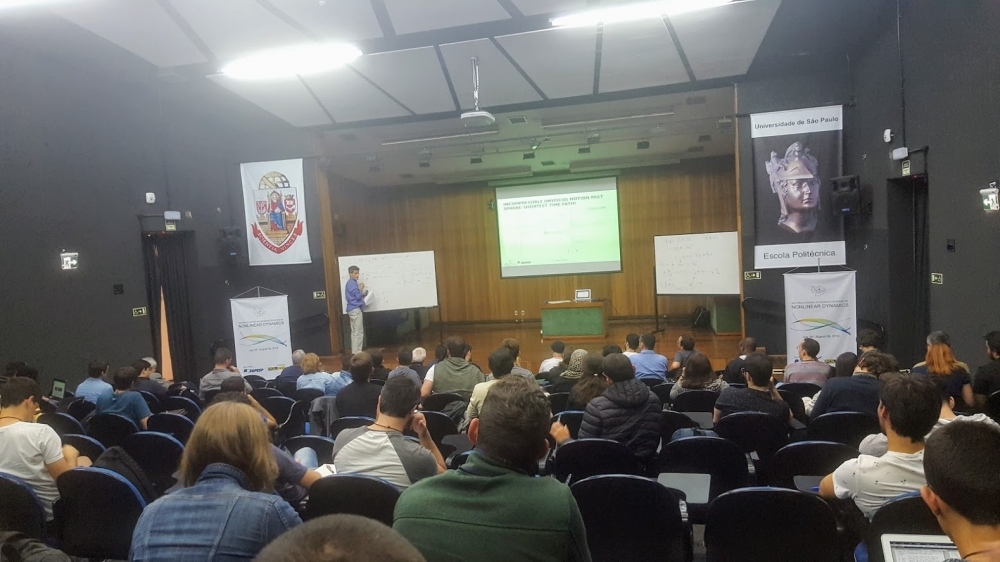

This FAPESP-supported School of Advanced Science discussed how applications of modeling to nonlinear dynamic systems have helped to predict effects such as vibration in civil engineering structures and dispersion in drug delivery (photo: Elton Alisson / Agência FAPESP)
This FAPESP-supported School of Advanced Science discussed how applications of modeling to nonlinear dynamic systems have helped to predict effects such as vibration in civil engineering structures and dispersion in drug delivery.
This FAPESP-supported School of Advanced Science discussed how applications of modeling to nonlinear dynamic systems have helped to predict effects such as vibration in civil engineering structures and dispersion in drug delivery.

This FAPESP-supported School of Advanced Science discussed how applications of modeling to nonlinear dynamic systems have helped to predict effects such as vibration in civil engineering structures and dispersion in drug delivery (photo: Elton Alisson / Agência FAPESP)
By Elton Alisson | Agência FAPESP – Research by mathematicians in an emerging field of study called dynamic systems has helped engineers achieve a deeper understanding of effects such as bridge vibration over time or the relationship between deep-sea oil drilling and the underwater pipelines used to transport the oil to the surface, for example, so that they can design structures better suited to phenomena that may occur during operations.
Some of the leading researchers in this relatively new area of mathematics assembled on July 29-August 9, 2019, to participate in the São Paulo School of Advanced Science on Nonlinear Dynamics, held at the University of São Paulo’s Engineering School (POLI-USP) in São Paulo, Brazil.
The event was supported by FAPESP via its São Paulo School of Advanced Science (SPSAS) program. The topics addressed included applications of mathematical modeling to dynamic systems in mechatronics and mechanical, civil, naval, oceanic and electrical engineering.
The lecturers were from Brazil and several other countries. A total of 120 PhD students and young researchers from 30 countries attended the School.
“The aim of the School was to show how mathematical modeling of dynamic systems can be used to solve engineering problems, or to develop structures and components that have certain desired physical behaviors in certain applications,” José Roberto Castilho Piqueira, Full Professor at POLI-USP and organizing committee chair, told Agência FAPESP.
According to Piqueira, dynamic systems is a field that involves the study of phenomena that evolve over time, such as climate, epidemics, chemical reactions and planetary systems.
Mathematical modeling with differential equations can be used to predict behaviors that may disturb the structural stability of these systems.
“This area of mathematics, which was founded by French polymath Henri Poincaré [1854-1912] over 100 years ago, has been very successful in Brazil,” Piqueira said.
“Professor Maurício Peixoto, who founded IMPA [Institute for Pure and Applied Mathematics, linked to Brazil’s Ministry of Education], and died in April, started studies in this area, in which Brazil has gained a significant standing. Another Brazilian mathematician, Artur Avila [who won the Fields Medal, the highest award for mathematics, in 2014], made important discoveries in this field,” he said.
In the 1970s and 1980s, it was discovered that dynamic systems can be both linear and nonlinear. Nonlinear dynamic systems may be chaotic, but their behavior can be predicted if the initial conditions are perfectly known.
Types of nonlinear dynamic systems include civil engineering structures such as bridges, transistor circuits and diodes in microelectronics, and fluids interacting with the structures through which they flow.
For example, fluid-structure interactions in a subsea oil pipeline can be described in terms of nonlinear dynamics, Piqueira explained. If these dynamics are simplified and treated as linear, unforeseen phenomena will occur during the lifetime of these structures even though they could have been predicted.
“The same applies to civil engineering structures that display phenomena such as mechanical vibrations at different frequencies,” he said.
Dispersion control
In fluid dynamics, research conducted in recent years by Roberto Camassa, Kenan Distinguished Professor of Mathematics at the University of North Carolina Chapel Hill (USA) and a lecturer at the SPSAS, helped explain how the size and shape of a pipe affects the spreading of particles suspended in the fluid flowing through the pipe.
In a study published in Science in 2016, Camassa and his team found that flows in rectangular ducts distribute particles asymmetrically along the flow direction, as opposed to the even spreading observed in circular or elliptical pipe flows.
To reach this conclusion, they developed a set of equations and performed computer simulations to study the distribution of a dye in a range of pipe shapes.
Their calculations predicted that the dye particles would be dragged by the fluid at different speeds depending on their positions and that the flow would be faster in the center of the pipe than in the vicinity of its walls.
The simulations showed that dispersion control resides solely in the ratio between pipe width and height, rather than in the properties of the fluid or the chemical dissolved in it.
For example, a solution flowing through a thin pipe reaches its target quickly, whereas the same solution flowing through a fat pipe travels to its target slowly.
“This is one of the universal natural principles governing the way solutions disperse,” Camassa said. “It can be used to optimize results in many industries that handle chemicals dissolved in fluid flows.”
The sectors that could benefit from these findings include medicinal chemistry and environmental management, where controlling drug delivery and the dispersion of chemicals or pollutants as they approach their final destination is key to optimizing their effectiveness, Camassa stressed.
Republish
The Agency FAPESP licenses news via Creative Commons (CC-BY-NC-ND) so that they can be republished free of charge and in a simple way by other digital or printed vehicles. Agência FAPESP must be credited as the source of the content being republished and the name of the reporter (if any) must be attributed. Using the HMTL button below allows compliance with these rules, detailed in Digital Republishing Policy FAPESP.





